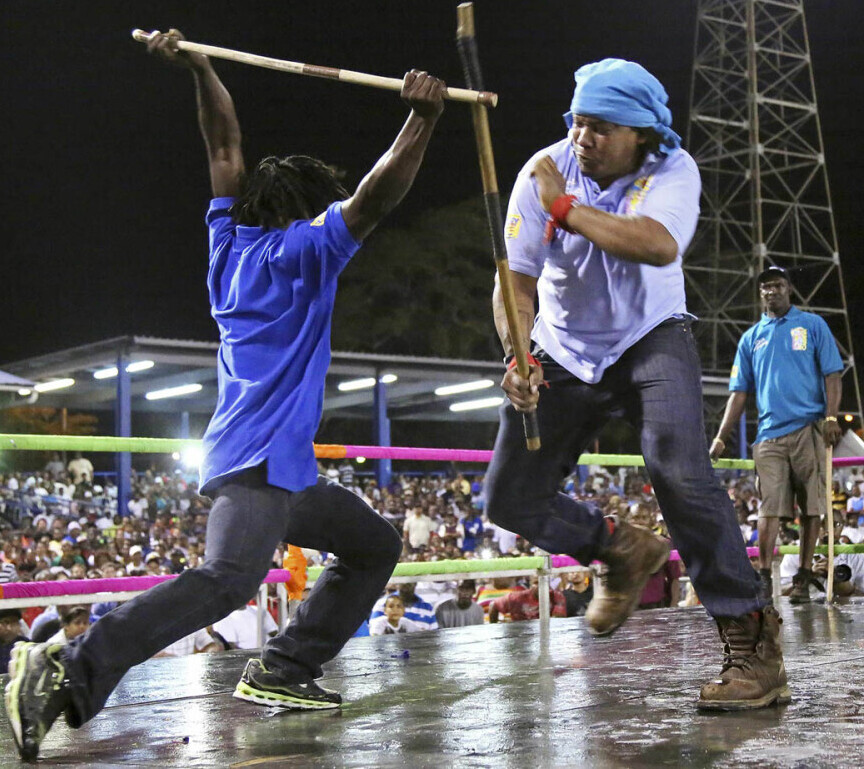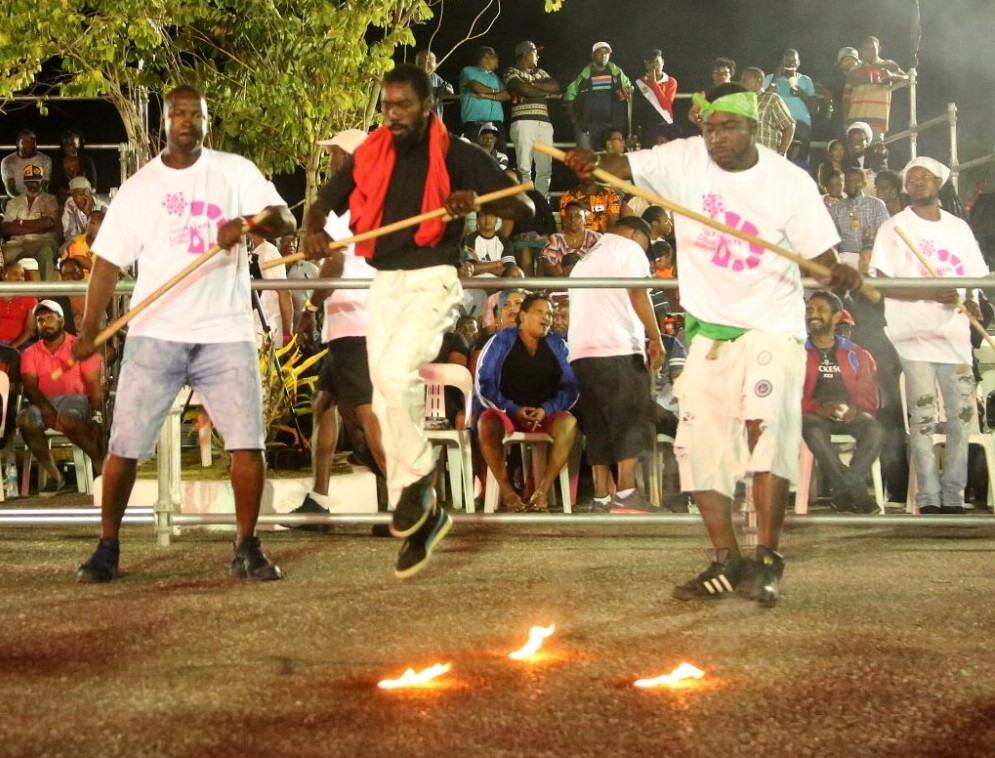 Stick fighting, also known as “kalinda,” is a vibrant and deeply rooted tradition in Trinidad’s cultural tapestry, particularly during the Carnival season.
Stick fighting, also known as “kalinda,” is a vibrant and deeply rooted tradition in Trinidad’s cultural tapestry, particularly during the Carnival season.
This martial art form, centered on skill, rhythm, and community, has its origins in the African heritage brought by enslaved people to the Caribbean. Over time, it evolved into a unique expression of resilience, spirituality, and artistry that continues to captivate audiences today.
Origins of Stick Fighting
The practice of stick fighting in Trinidad traces its roots to the African combative traditions brought over during the transatlantic slave trade. These traditions, combined with the cultural exchanges among African, Indigenous, and European peoples, gave birth to kalinda.
During slavery, it served not only as a form of self-defense but also as a means of preserving African identity and fostering community solidarity. After Emancipation, kalinda became an integral part of the Carnival celebrations, symbolizing freedom, resistance, and the enduring spirit of the people.
Traditional Hubs of Stick Fighting
Stick fighting remains a cornerstone of community identity in many parts of Trinidad. Towns and villages such as Moruga, Couva, Mayaro, and Cedros have long-standing traditions of hosting “gayelles,” the circular arenas where bouts take place.
These areas are renowned for their fierce yet respectful competitions, where fighters, or “boismen,” showcase their skills and honor their heritage. Over the years, these communities have nurtured generations of stickfighters, passing down their knowledge and techniques through oral traditions and practice.
Famous Stickfighters
Trinidad’s history of stick fighting is adorned with legendary boismen who have left an indelible mark on the art form. Figures such as King Kali, the invincible fighter from Moruga, and Mighty Tiger, a master strategist known for his agility, are celebrated for their prowess and showmanship.
These individuals not only excelled in the gayelle but also inspired others to embrace the discipline and artistry of stick fighting. Their stories continue to be recounted with reverence, adding to the mystique and allure of kalinda.
The Music of Kalinda
Central to the stick fighting tradition is the music that accompanies the bouts. The tamboo bamboo and drums, particularly the “bois drum,” set the rhythm for the gayelle, creating an electrifying atmosphere.
The chantwell, a lead singer, guides the proceedings with kalinda songs, whose lyrics often tell tales of bravery, humor, and social commentary. These songs, rooted in the oral tradition, energize the boismen and connect the audience to the action in the arena.
The combination of rhythm and song transforms the gayelle into a dynamic, almost sacred space where history and culture come alive.
Rituals and Spirituality
 Stick fighting is steeped in rituals that underscore its cultural and spiritual significance. Before entering the gayelle, boismen undergo blessings and rituals to protect them from harm and invoke the favor of ancestral spirits.
Stick fighting is steeped in rituals that underscore its cultural and spiritual significance. Before entering the gayelle, boismen undergo blessings and rituals to protect them from harm and invoke the favor of ancestral spirits.
The arena itself is often consecrated, emphasizing its role as a sacred space for skill and honor. These rituals reflect the deep connection between kalinda and African spiritual practices, highlighting the art form’s role as more than just physical combat but also a spiritual journey.
The Bois and Strategy
The primary weapon in stick fighting is the “bois,” a carefully crafted wooden stick typically made from poui or other sturdy local woods.
The boismen wield their bois with precision, relying on a combination of movements, strategies, and intuition. Kalinda involves fluid footwork, quick reflexes, and calculated strikes, making it as much a mental game as a physical one.
Fighters often engage in feints and deceptive movements to outsmart their opponents, showcasing not only their strength but also their intelligence and creativity.
The Gayelle: Heart of the Action
At the center of the stick fighting tradition is the gayelle, a circular arena that comes alive during Carnival. The energy in the gayelle is palpable, with the crowd cheering, the drums pounding, and the chantwell’s voice ringing out.
The boismen enter the arena with pride, each bout a test of skill, courage, and endurance. The gayelle becomes a microcosm of Trinidadian culture, where the past and present collide in a vibrant display of artistry and resilience.
Stick Fighting and Carnival
Stick fighting is an enduring symbol of Trinidad Carnival, embodying the spirit of liberation and cultural expression. It serves as a reminder of the resilience of the African ancestors who forged this tradition against the odds.
Today, kalinda remains a must-see spectacle, drawing locals and visitors alike to witness the electrifying energy of the gayelle. The rhythmic beats, spirited chants, and fierce battles create an atmosphere unlike any other, leaving spectators in awe of this living tradition.
Experiencing stick fighting during Trinidad Carnival is a journey into the heart of the island’s cultural heritage. The gayelle’s vibrant energy, the artistry of the boismen, and the pulsating rhythms of the music combine to create an unforgettable experience.
Whether you’re a first-time visitor or a seasoned Carnival enthusiast, the magic of kalinda will leave you inspired and eager to return. It’s more than a spectacle—it’s a celebration of history, community, and the indomitable spirit of Trinidad and Tobago.
Stick fighting, or Kalinda, is an extraordinary tradition that embodies Trinidad and Tobago’s spirit, resilience, and cultural richness. More than just a combat sport, it is a dynamic expression of history, identity, and artistry deeply rooted in African heritage. The gayelle serves as a sacred space where skill, rhythm, and storytelling merge, bringing the past to life through each carefully executed strike and chant.
What makes stick fighting truly remarkable is its blend of physical prowess and mental strategy. The boismen’s use of feints, footwork, and calculated strikes showcases not just strength but intelligence and discipline. The presence of legendary figures such as King Kali and Mighty Tiger adds to the grandeur, inspiring new generations to embrace this ancient art form.
Equally captivating is the role of music and ritual in kalinda. The powerful rhythms of tamboo bamboo and bois drums, combined with the chantwell’s evocative songs, create an atmosphere of energy and reverence. Stick fighting remains an unmissable Carnival tradition, serving as a tribute to the enduring legacy of those who fought to preserve their culture and freedom.